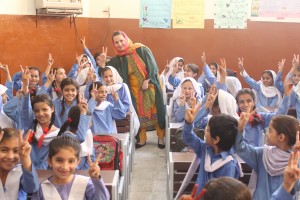Improving school facilities to improve student experience
News Story
New furniture helps keep Afghan refugee and Pakistani children in schools
QUETTA, 31 May, 2017: Nine year-old Nadia Abdul Waris attends school with enthusiasm since her school has received new sets furniture for students. “Sitting on the floor was very uncomfortable and I always wished to go to a well-furnished school as shown on TV,” says the fourth grade student of government girls high school, Killi Alam Khan in Pakistan’s north-western city of Quetta.
Killi Alam Khan, is one of the twenty-six government schools where the UN Refugee Agency (UNHCR) provided furniture earlier this year. The school furniture initiative was funded by the United States of America, currently, one of UNHCR’s biggest donors worldwide. UNHCR distributed the furniture in public schools through the Provincial Education Department of Balochistan.
Nadia and her four best friends now love their fully furnished, bright classroom and colourful school building. The girls feel more comfortable during their classwork and enjoy not sitting on the floor.
The principal of Nadia’s school, Qaisra Naseem, stated that the majority of students in her school are underprivileged having limited access to the basic facilities of life. She noted that school facilities can have a profound impact on both teacher and student outcomes and contribute greatly to improved learning environment.
Ms Naseem and her staff with limited resources took on the initiative of improving the overall look of school by decorating the walls involving the students.
Naseem expressed gratitude towards UNHCR and the people of the United States of America for making it possible to create a supportive environment for learning. “The provision of furniture will encourage more girls to attend school as well as send a positive message to the community for the promotion of girls’ education.” She noted.
According to Naseem, Balochistan has the highest proportion of out-of-school children, as well high drop-out rate. The lack of basic facilities like furniture in schools only contributes to the already exacerbated plight of education.
The doors of the government girls high school, Killi Alam Khan, are open equally to children from Pakistani as well as Afghan refugees residing in Quetta. Nadia’s best friend, Sahiba Agha is an Afghan refugee born in Pakistan. Just like the rest of her classmates, she too loves the new look of her classroom.
Inspired by her teachers, Sahiba too wants to become a teacher. Sharing her future plans, Sahiba said: “I will build a beautiful school with colourful walls, bright classroom and a playground. I will buy furniture similar to my school.”
Dinesh Shrestha, head of UNHCR Quetta, appreciated the generosity of the people and government of Pakistan for hosting Afghan refugees for nearly four decades.
He said: “Education has consistently been recognised as the cornerstone of development for any country or region. Through our partner organisations and support from international community, UNHCR is working to ensure that the poorest and most marginalised children in Balochistan can go to school, can stay in school and can have access to a quality school education.”
School selection for the furniture was done after a joint assessment carried out by UNHCR and the provincial education department of Balochistan. Some 14,800 students in 26 public schools, both Pakistani and Afghan refugees, have benefitted from the initiative in Quetta city.
The furniture included sets of 1,125 two seater desks and benches, 105 teacher chairs, 105 teacher tables, 105 rostrums, 105 staff room tables, 630 staff room teacher chairs, 900 tables and chairs for students, 450 computer tables, 30 teacher tables for computer labs, 30 side-racks, 8 laboratory tables, 900 laboratory stools, 135 white boards, 240 cupboards for class rooms, 30 cupboards for science lab, 900 computer chairs for students and 30 chairs for the computer labs for teachers.
By Humera Karim in Quetta







Mia Allah Mir
i have been living since 1982 in GamKol Camp Kohat pakistan.and also i have been teaching since 1998 in refugee school.
the refugees school are not a school it is only a prison for children.i have some valid proof of these school.
our students don’t have complete books , clean drinking water system, wash room and a sports ground.
in my mind they are not schools
in each class we have over 60 students and some girls school have 270 students but they have only 3 teachers.
How can it is possible that a teacher teach correctly and properly